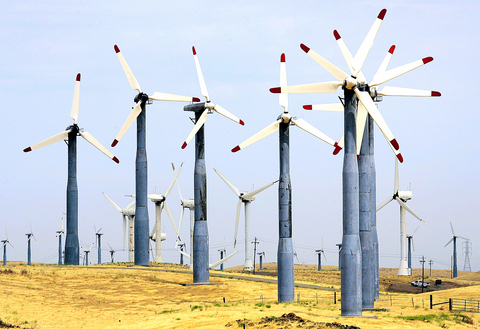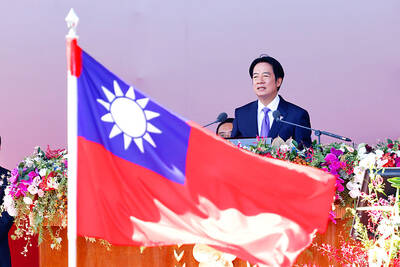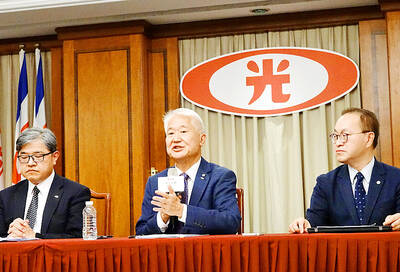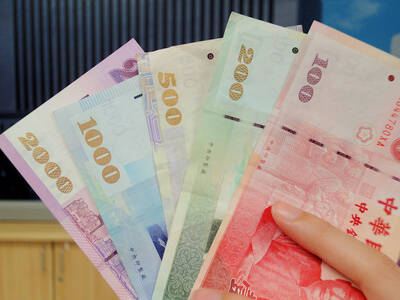When Suzlon Energy Ltd officials were looking for a place to build turbine parts for the booming US wind energy market, they could see as far as the flat horizon here allows.
With Minnesota among the top five US states in wind energy generation, and primed to double its capacity by 2010, the company is setting up its first US plant in this windswept farm town.
"With green energy the way it is, and the huge US market, we can see 100 years of life for our plant," said Jim Streiff, a vice president for Suzlon Rotor, the subsidiary that will run the Pipestone facility.

PHOTO: AP
By the end of this year, Suzlon Energy hopes to make the leap to third place in turbine sales in the US, up from fifth last year. GE Energy, based in Atlanta, Georgia, is the US' biggest domestic seller of wind turbines.
The company reported worldwide sales of US$830 million for the year ended March 31. In the US, Suzlon commissioned 80 turbines over the past year and hopes to sell more than 200 over the next year. All of their turbines are being sold to local investors and farmers, who pay between US$1 million and US$2 million for each.
A mix of federal and tax incentives, not to mention high fuel prices, are drawing local investors into the wind market. The federal government, for instance, offers a US$0.019-per-killowatt hour tax credit; in Minnesota, the state offers another US$0.015 credit. Small investors in Minnesota can negotiate with utility companies for further production credits.
According to the Minnesota Department of Employment and Economic Development, one or two turbines can generate profits of US$100,000 per year, once the capital expenditures are paid off.
Last fall, Suzlon Rotor broke ground on a US$14 million plant the size of two-and-a-half football fields on the edge of Pipestone. The plant will employ 275 people and churn out its first rotor in October. The rotor comprises the three blades of a turbine, the nose cone and the mechanics inside the cone.
Suzlon Energy already makes the rotors in India. But the high cost of shipping the parts and the chance to get in on the ground floor in the US market -- where just 1 percent of the electricity comes from wind energy -- proved enticing.
GE Energy, Spain-based Gamesa Eolica and Clipper Windpower of Carpinteria, California, are among the other turbine makers hoping to capitalize on the growing US market. Clipper opened a plant in Cedar Rapids, Iowa, several months ago.
"What we are seeing is more investment among manufacturers in opening plants, and that is a reflection of the speed of the North American market," said Christine Real de Azua, a spokeswoman for the American Wind Energy Association.
Among the new power plants that came on line last year, wind power was second after new natural gas, she said.
Beyond Minnesota, a number of other states beckon. California has the most installed capacity, followed by Texas, Iowa and Minnesota, according to the American Wind Energy Association.
In Minnesota, there is currently enough capacity to generate about 750 megawatts of wind energy. The legislature and Governor Tim Pawlenty have set a goal of 800 new megawatts of community-based wind energy by 2010.

People can preregister to receive their NT$10,000 (US$325) cash distributed from the central government on Nov. 5 after President William Lai (賴清德) yesterday signed the Special Budget for Strengthening Economic, Social and National Security Resilience, the Executive Yuan told a news conference last night. The special budget, passed by the Legislative Yuan on Friday last week with a cash handout budget of NT$236 billion, was officially submitted to the Executive Yuan and the Presidential Office yesterday afternoon. People can register through the official Web site at https://10000.gov.tw to have the funds deposited into their bank accounts, withdraw the funds at automated teller

PEACE AND STABILITY: Maintaining the cross-strait ‘status quo’ has long been the government’s position, the Ministry of Foreign Affairs said Taiwan is committed to maintaining the cross-strait “status quo” and seeks no escalation of tensions, the Ministry of Foreign Affairs (MOFA) said yesterday, rebutting a Time magazine opinion piece that described President William Lai (賴清德) as a “reckless leader.” The article, titled “The US Must Beware of Taiwan’s Reckless Leader,” was written by Lyle Goldstein, director of the Asia Program at the Washington-based Defense Priorities think tank. Goldstein wrote that Taiwan is “the world’s most dangerous flashpoint” amid ongoing conflicts in the Middle East and Russia’s invasion of Ukraine. He said that the situation in the Taiwan Strait has become less stable

CONCESSION: A Shin Kong official said that the firm was ‘willing to contribute’ to the nation, as the move would enable Nvidia Crop to build its headquarters in Taiwan Shin Kong Life Insurance Co (新光人壽) yesterday said it would relinquish land-use rights, or known as surface rights, for two plots in Taipei’s Beitou District (北投), paving the way for Nvidia Corp to expand its office footprint in Taiwan. The insurer said it made the decision “in the interest of the nation’s greater good” and would not seek compensation from taxpayers for potential future losses, calling the move a gesture to resolve a months-long impasse among the insurer, the Taipei City Government and the US chip giant. “The decision was made on the condition that the Taipei City Government reimburses the related

FRESH LOOK: A committee would gather expert and public input on the themes and visual motifs that would appear on the notes, the central bank governor said The central bank has launched a comprehensive redesign of New Taiwan dollar banknotes to enhance anti-counterfeiting measures, improve accessibility and align the bills with global sustainability standards, Governor Yang Chin-long (楊金龍) told a meeting of the legislature’s Finance Committee yesterday. The overhaul would affect all five denominations — NT$100, NT$200, NT$500, NT$1,000 and NT$2,000 notes — but not coins, Yang said. It would be the first major update to the banknotes in 24 years, as the current series, introduced in 2001, has remained in circulation amid rapid advances in printing technology and security standards. “Updating the notes is essential to safeguard the integrity